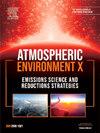室内PM2.5中重金属的综合分析:孟加拉国达卡的来源识别和健康风险评估
IF 3.4
Q2 ENVIRONMENTAL SCIENCES
引用次数: 0
摘要
室内空气污染及其相关的健康风险已成为发展中国家严重关切的问题。这项研究分析了从孟加拉国达卡的六个室内地点收集的颗粒物(PM2.5)。采用电感耦合等离子体质谱法(ICP-MS)测定了13种重金属(Pb、Cd、Cr、Zn、Be、V、Ni、Hg、As、Co、Se、Mn、Cu)的浓度。其中,Mn、Cd、Hg和Pb超过美国环境保护署(USEPA)的指导值,其中Hg超过USEPA阈值50倍以上,Cd超过6倍以上,Pb超过4倍,表明存在较大的人为影响。Zn和Pb是室内PM2.5的主要贡献者,其中Zn、Pb、Hg、Se和Cd富集程度较高,表明人为影响较大。主成分分析(PCA)揭示了两个主要成分,解释了总方差的71.26%。酸碱度分析显示,达卡的PM2.5以酸性为主,NO3 -和SO42 -浓度较高,进一步支持了人为活动的作用。非致癌风险评估显示,三个地点的危害指数(HI)值超过10,其中Ni、Mn和Cd对儿童和成人都构成最大风险。对于致癌风险,所有地点的总癌症风险(TCR)值都超过了可接受的阈值。铬、镉和砷是TCR的主要贡献者,由于终生接触,成人的风险始终高于儿童。这项研究为达卡的室内空气质量挑战提供了新的、与政策相关的证据,强调了在密集的城市环境中采取有针对性的干预措施以减轻重金属暴露和保障公众健康的迫切需要。本文章由计算机程序翻译,如有差异,请以英文原文为准。
Comprehensive analysis of heavy metals in indoor PM2.5: Source identification and health risk assessment in Dhaka, Bangladesh
Indoor air pollution and its associated health risks have become a critical concern in developing countries. This study analyzed particulate matter (PM2.5) collected from six indoor locations in Dhaka, Bangladesh. Inductively Coupled Plasma Mass Spectrometry (ICP-MS) was used for measuring the concentration of thirteen heavy metals (Pb, Cd, Cr, Zn, Be, V, Ni, Hg, As, Co, Se, Mn, and Cu). Among these, Mn, Cd, Hg, and Pb exceeded United States Environmental Protection Agency (USEPA) guideline values, with Hg surpassing USEPA thresholds by over 50 times, Cd by more than 6-fold, and Pb by over fourfold, indicating substantial anthropogenic influence. Zn and Pb were identified as the primary contributors to indoor PM2.5, with high enrichment of Zn, Pb, Hg, Se, and Cd indicating strong anthropogenic influence. Principal Component Analysis (PCA) revealed two major components, explaining 71.26 % of the total variance. Acidity-alkalinity analysis revealed that PM2.5 in Dhaka was predominantly acidic, with greater concentrations of NO3− and SO42− further supporting the role of anthropogenic activities. Non-carcinogenic risk assessment showed hazard index (HI) values exceeding 10 at three locations, with Ni, Mn, and Cd posing the greatest risks for both children and adults. For carcinogenic risks, Total Cancer Risk (TCR) values at all sites exceeded acceptable thresholds. Cr, Cd, and As were the dominant contributors to TCR, and adults consistently exhibited higher risks than children due to lifetime exposure. This study provides novel, policy-relevant evidence on indoor air quality challenges in Dhaka, highlighting the urgent need for targeted interventions to mitigate heavy metal exposure and safeguard public health in dense urban environments.
求助全文
通过发布文献求助,成功后即可免费获取论文全文。
去求助
来源期刊

Atmospheric Environment: X
Environmental Science-Environmental Science (all)
CiteScore
8.00
自引率
0.00%
发文量
47
审稿时长
12 weeks
 求助内容:
求助内容: 应助结果提醒方式:
应助结果提醒方式:


